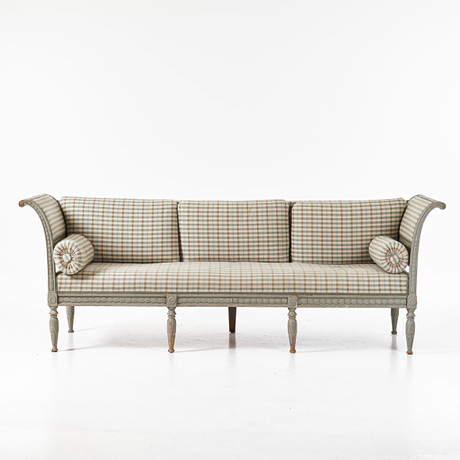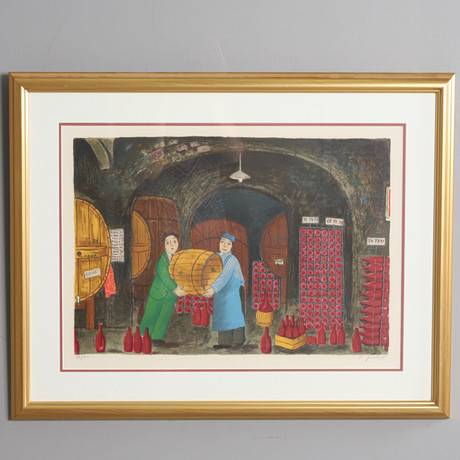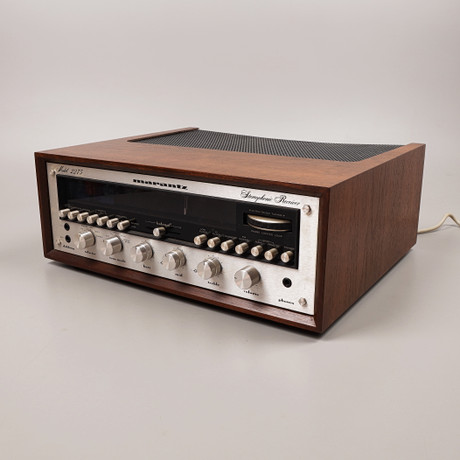
562. Chest of drawers, high quality Gustavian Stockholm work, executed in Georg Haupt's circle during the 1770/80s, veneered with amaranth, boxwood, dyed birch, maple and rosewood, matt, polished and ciselated burnt-gilt fittings in bronze.
This auction is closed, but maybe you like the following items?





Description
Front with protruding middle part, top drawer front with ribbon braid, fleurons and plant ornamentation, matted and polished torch strip, co-composed front with field division, central motif in friezes and fields with engraved bearing festoon illusory suspended in fleurons, side bars inlaid with trellis motifs filled with floral rosettes, pull handles in the form of bearings garlands and lenses, lambrequin with cornice fittings with band rosette and leaf rod, oblique corners with brackets of plant ornamentation and volutes, side pieces with friezes with engraved bearing festoon illusorically suspended in fleurons, rear posts with acanthus bows, convertible legs with fittings of acanthus ornamentation, limestone disc, upper box with ink inscription “Renovad 1922 af Adolf Hedman Möbelsnickare”, a clasp stamped E under crown (Eskilstuna Fristad), height 83, 94 x 50.5 cm
Compare unsigned chest of drawers by Georg Haupt in Verner von Heidenstams Övralid, Östergötland
PROVENANCE: Likely acquired by Captain Rudolf Nydahl (1882-1973) and his wife Daisy, née von Brömssen (1896-1980), in connection with the couple's move in 1920 to a flat at Riddargatan 35 in Stockholm
subsequently inherited within the family of the present owner
LITERATURE: Bukowski Auktioner, auction, 16-18 April 1925, no 113, compare unsigned bureau by Georg Haupt
Ernst Fischer: Swedish furniture in picture, Stockholm 1938, page 171, compare similar dresser made by Georg Haupt 1778, in Kungl. Housewares Chamber
Marshall Lagerquist: Georg Haupt - Ebéniste du Roi, Stockholm 1979, page 96, compare detail on secretary by Georg Haupt; page 111f, compare dresser dated 1 November 1778; page 152, compare key signs on secretary signed and dated by Haupt 1784; page 164, compare dresser signed and dated by Georg Haupt 1777, formerly in Carl Robert Lamm's collections
Torsten Sylvén: Mästernas Möbler - Stockholmsarbeten 1700-1850, Stockholm 1996, page 425, compare sections on furniture masters' characteristics regarding flower rosettes
Lars Ljungström: Georg Haupt - Gustav III's court chatullmaker, Stockholm 2006, page 38 and page 89, footnote 51, section on “Georg Haupt and his compatriots in London”, featuring Johan Christian Linning in the 1770s
Few craftsmen can be said to have lived in harmony with their material as Haupt did, through an immense sense of composition, colour and technique, as well as high demands on the material and quality of the work. The newly discovered chest of drawers in the auction is closely related to Georg Haupt's oeuvre through its obvious stylistic similarities to signed chests of drawers executed by the master, but in terms of construction it deviates from the usual picture of Haupt's works. Slightly simplified, it is either a Haupt with atypical construction and heavier fittings than usual, as some details speak for, or it is a skillful contemporary imitation of an initiated Ebenist in his immediate circle which is a likely conclusion. The closest given contemporary office-masters are the brothers Gottlieb and Fredrich Iwersson, with the former assuming Haupt's title as castle carpenter after his death in 1784. Both Georg Haupt and Gottlieb Iwersson's engravings are of such a high quality that the differences are difficult to distinguish, while Fredrich exceptionally rose to the level of quality at the auction agency.
Stylistically, there are four known chests of drawers by Haupt that can be said to constitute a reference material in comparative studies: an unsigned chest of drawers in Verner von Heidenstam's Övralid; a chest of drawers formerly in Carl Robert Lamm's collections, signed and dated 1777; a chest of drawers in Kungl. Husgerådskammaren signed and dated 1 November 1778; and an unsigned chest of drawers sold at Bukowskis in 1925. Thus, in terms of time, the production period is around the late 1770s or early 1780s, an essential small detail indicates that the originator was even in Haupt's workshop and carried out the agency. Haupt generally has the same design on its flower rosettes, which are executed from boxwood or lemon wood. The pistil in the centre of the rosette has Haupt cut out and twisted a quarter turn and thus angled in a different fibre direction on the wood, as is also the case with the auction intarsia choir, which requires a high level of detail knowledge of Haupt's work.
In addition to the intarsia works, the agency has a high-quality set of fittings with obvious kinship to the great master, but parts appear heavier and extraordinary in their details. For example, the rear bow fittings on the dresser are of a type found in - what must be - two different manufactures. The versions differ in that the ball in the middle is higher on one (also the rest have a slightly higher relief effect). The agency of the auction has fittings of the lower type, such as Anders Lundelius has consistently used it, but Haupt mostly has the higher one, but there are examples of him also using the second variant. In preparation for cataloguing by the agency, all fittings have been removed and cleaned, in connection with this work it was found that the majority of the brass nails were original and probably fittings have not been removed since the time of manufacture.
For some reason, the court carpenter, office master and court chattel maker Johan Christian Linning, who was the son of the well-known Christian Linning, is often forgotten when thinking about who could possibly make really good furniture in the spirit of Haupt. Johan Christian was not only Haupt's brother-in-law, but he has also left behind a handful of pieces of furniture that stylistically belong to Haupt's oeuvre and which have sometimes been described as his own work. Here are: a secretary sold at Beijers November 20, 1986, No. 448; a chest of drawers sold at Bukowski's in spring 2007, No. 983; and a secretary sold at Sotheby's, New York April 5, 2000, No. 398A. In addition to Georg Haupt marrying Christian Linning's daughter Anna Elisabet in 1771, he also performed his masterpiece in his father-in-law Christian Linning's workshop.
For a couple of years in the 1770s (contemporary with the two signed Haupt bureaus with the same façade composition as that of the auction) Johan Christian Linning must have worked more or less independently under the protection of some Stockholm master, probably Haupt. Linning had somehow convinced the Swedish ambassador in London, von Nolcken, to bring an intarsia plaque when he went home in 1775 and courted Gustav III. The result was that in 1776 Linning returned to Sweden and was appointed court carpenter, which was a good merit, but the assignments from the court were not numerous and the appointment was not legally valid for conducting sales to the public. In addition to this, one was required to be a master either in the crook or under the court of law, but Linning did not become a master until 1779. Somehow he must have made a living in the three intervening years and, predictably, he did so through collaboration with Haupt. All the data we have about the carpenters' cases are based on mantal lengths and, to some extent, house interrogation protocols. This means that those found in different reviews are the messels that were counted for the Haupt household. Anyone who had their own residence elsewhere is missing from the source material, this source of error is almost never mentioned in the literature, but is all but immaterial. Johan Christian may in fact have been in Haupt's workshop in the current years without being included in Marshall Lagerquist's list and, given Linning's professional experience in London, he has in all probability worked very independently, without being taught all Haupt's solutions as a guide.
Condition
Partial veneer damage, repairs and additions, the disc probably not original and with repairs.
Key/keys included.
Sale
Do you have something similar to sell? Get your items valued free of charge!
Bidding
Hammer auction
Have your item valued free of charge.
Bid history
| 5 | 12 Jun, 04:57 | 24 215 EUR |
| The reserve price of 17 937 EUR was met. | ||
| Only the highest room bid is shown above. | ||
| 4 | 9 Jun, 17:10 | 13 453 EUR |
| 1 | 9 Jun, 16:25 | 10 763 EUR |
| Show all 13 bids | ||
Description
Front with protruding middle part, top drawer front with ribbon braid, fleurons and plant ornamentation, matted and polished torch strip, co-composed front with field division, central motif in friezes and fields with engraved bearing festoon illusory suspended in fleurons, side bars inlaid with trellis motifs filled with floral rosettes, pull handles in the form of bearings garlands and lenses, lambrequin with cornice fittings with band rosette and leaf rod, oblique corners with brackets of plant ornamentation and volutes, side pieces with friezes with engraved bearing festoon illusorically suspended in fleurons, rear posts with acanthus bows, convertible legs with fittings of acanthus ornamentation, limestone disc, upper box with ink inscription “Renovad 1922 af Adolf Hedman Möbelsnickare”, a clasp stamped E under crown (Eskilstuna Fristad), height 83, 94 x 50.5 cm
Compare unsigned chest of drawers by Georg Haupt in Verner von Heidenstams Övralid, Östergötland
PROVENANCE: Likely acquired by Captain Rudolf Nydahl (1882-1973) and his wife Daisy, née von Brömssen (1896-1980), in connection with the couple's move in 1920 to a flat at Riddargatan 35 in Stockholm
subsequently inherited within the family of the present owner
LITERATURE: Bukowski Auktioner, auction, 16-18 April 1925, no 113, compare unsigned bureau by Georg Haupt
Ernst Fischer: Swedish furniture in picture, Stockholm 1938, page 171, compare similar dresser made by Georg Haupt 1778, in Kungl. Housewares Chamber
Marshall Lagerquist: Georg Haupt - Ebéniste du Roi, Stockholm 1979, page 96, compare detail on secretary by Georg Haupt; page 111f, compare dresser dated 1 November 1778; page 152, compare key signs on secretary signed and dated by Haupt 1784; page 164, compare dresser signed and dated by Georg Haupt 1777, formerly in Carl Robert Lamm's collections
Torsten Sylvén: Mästernas Möbler - Stockholmsarbeten 1700-1850, Stockholm 1996, page 425, compare sections on furniture masters' characteristics regarding flower rosettes
Lars Ljungström: Georg Haupt - Gustav III's court chatullmaker, Stockholm 2006, page 38 and page 89, footnote 51, section on “Georg Haupt and his compatriots in London”, featuring Johan Christian Linning in the 1770s
Few craftsmen can be said to have lived in harmony with their material as Haupt did, through an immense sense of composition, colour and technique, as well as high demands on the material and quality of the work. The newly discovered chest of drawers in the auction is closely related to Georg Haupt's oeuvre through its obvious stylistic similarities to signed chests of drawers executed by the master, but in terms of construction it deviates from the usual picture of Haupt's works. Slightly simplified, it is either a Haupt with atypical construction and heavier fittings than usual, as some details speak for, or it is a skillful contemporary imitation of an initiated Ebenist in his immediate circle which is a likely conclusion. The closest given contemporary office-masters are the brothers Gottlieb and Fredrich Iwersson, with the former assuming Haupt's title as castle carpenter after his death in 1784. Both Georg Haupt and Gottlieb Iwersson's engravings are of such a high quality that the differences are difficult to distinguish, while Fredrich exceptionally rose to the level of quality at the auction agency.
Stylistically, there are four known chests of drawers by Haupt that can be said to constitute a reference material in comparative studies: an unsigned chest of drawers in Verner von Heidenstam's Övralid; a chest of drawers formerly in Carl Robert Lamm's collections, signed and dated 1777; a chest of drawers in Kungl. Husgerådskammaren signed and dated 1 November 1778; and an unsigned chest of drawers sold at Bukowskis in 1925. Thus, in terms of time, the production period is around the late 1770s or early 1780s, an essential small detail indicates that the originator was even in Haupt's workshop and carried out the agency. Haupt generally has the same design on its flower rosettes, which are executed from boxwood or lemon wood. The pistil in the centre of the rosette has Haupt cut out and twisted a quarter turn and thus angled in a different fibre direction on the wood, as is also the case with the auction intarsia choir, which requires a high level of detail knowledge of Haupt's work.
In addition to the intarsia works, the agency has a high-quality set of fittings with obvious kinship to the great master, but parts appear heavier and extraordinary in their details. For example, the rear bow fittings on the dresser are of a type found in - what must be - two different manufactures. The versions differ in that the ball in the middle is higher on one (also the rest have a slightly higher relief effect). The agency of the auction has fittings of the lower type, such as Anders Lundelius has consistently used it, but Haupt mostly has the higher one, but there are examples of him also using the second variant. In preparation for cataloguing by the agency, all fittings have been removed and cleaned, in connection with this work it was found that the majority of the brass nails were original and probably fittings have not been removed since the time of manufacture.
For some reason, the court carpenter, office master and court chattel maker Johan Christian Linning, who was the son of the well-known Christian Linning, is often forgotten when thinking about who could possibly make really good furniture in the spirit of Haupt. Johan Christian was not only Haupt's brother-in-law, but he has also left behind a handful of pieces of furniture that stylistically belong to Haupt's oeuvre and which have sometimes been described as his own work. Here are: a secretary sold at Beijers November 20, 1986, No. 448; a chest of drawers sold at Bukowski's in spring 2007, No. 983; and a secretary sold at Sotheby's, New York April 5, 2000, No. 398A. In addition to Georg Haupt marrying Christian Linning's daughter Anna Elisabet in 1771, he also performed his masterpiece in his father-in-law Christian Linning's workshop.
For a couple of years in the 1770s (contemporary with the two signed Haupt bureaus with the same façade composition as that of the auction) Johan Christian Linning must have worked more or less independently under the protection of some Stockholm master, probably Haupt. Linning had somehow convinced the Swedish ambassador in London, von Nolcken, to bring an intarsia plaque when he went home in 1775 and courted Gustav III. The result was that in 1776 Linning returned to Sweden and was appointed court carpenter, which was a good merit, but the assignments from the court were not numerous and the appointment was not legally valid for conducting sales to the public. In addition to this, one was required to be a master either in the crook or under the court of law, but Linning did not become a master until 1779. Somehow he must have made a living in the three intervening years and, predictably, he did so through collaboration with Haupt. All the data we have about the carpenters' cases are based on mantal lengths and, to some extent, house interrogation protocols. This means that those found in different reviews are the messels that were counted for the Haupt household. Anyone who had their own residence elsewhere is missing from the source material, this source of error is almost never mentioned in the literature, but is all but immaterial. Johan Christian may in fact have been in Haupt's workshop in the current years without being included in Marshall Lagerquist's list and, given Linning's professional experience in London, he has in all probability worked very independently, without being taught all Haupt's solutions as a guide.
Condition
Partial veneer damage, repairs and additions, the disc probably not original and with repairs.
Key/keys included.
Sale
Do you have something similar to sell? Get your items valued free of charge!
Details
- Catalogue no
- 562
Fine Art & Antiques Spring 2024
In our spring auction Fine Art & Antiques we present a collection that spans from the Ming Dynasty to Carl Milles’ works of the 1920s – encompassing a wide array of fascinating items in between. These objects not only carry their own histories but also tell stories about the people who created and lived with them. Among the highlights are Märta Helena Reenstierna’s cabinet from Årsta Manor, Marc Chagall’s vibrant painting “L’envolée Magique,” and Alma Pihl’s exquisite Winter Egg from the House of Fabergé in Saint Petersburg. These pieces are now featured in the Stockholms Auktionsverks´ catalog, poised to continue their journeys through time.
We invite you to explore the curated exhibition at Nybrogatan 32, meticulously organized by the leading specialists at Stockholms Auktionsverk.
AUCTION SCHEDULE
Tuesday, June 11, starting at 10:00 AM
Asian Art and Crafts: Lots 1-186
Tuesday, June 11, starting at 1:00 PM
Art, Drawings, and prints from the 1800s: Lots 187-376
Swedish Old Masters and Drawings: Lots 377-393
Old Masters: Lots 394-430
Wednesday, June 12, starting at 10:00 AM
Silver: Lots 431-494
Curiosity Cabinet: Lots 495-541
Antique Furniture and Crafts: Lots 542-655
Oriental Carpets & Textiles: Lots 656-699
Jewelry: Lots 700-782
Watches: Lots 783-785





























